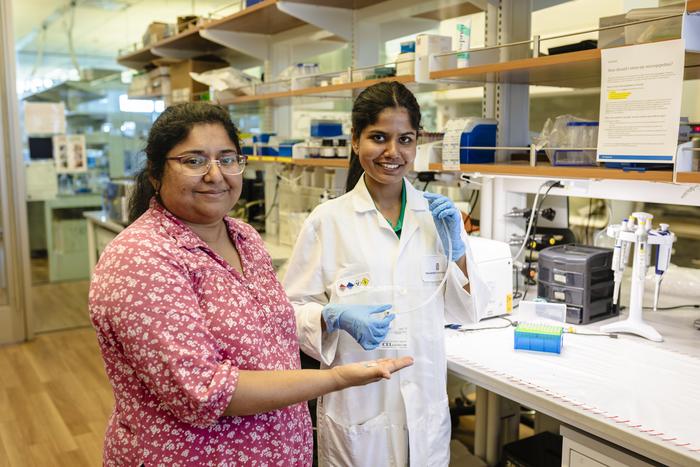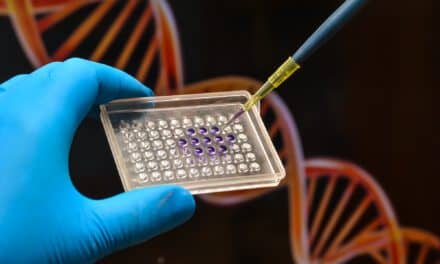University of Texas at Dallas researchers combine electrochemical biosensors with AI to identify volatile organic compounds linked to thoracic cancers.
Researchers at the University of Texas at Dallas have developed biosensor technology that, when combined with artificial intelligence (AI), shows potential for detecting lung cancer through breath analysis.
The electrochemical biosensor identifies eight volatile organic compounds (VOCs) that serve as potential biomarkers for thoracic cancers, including lung and esophageal cancers. AI then analyzes the biochemical characteristics of the compounds to determine whether they match those linked to various thoracic cancers.
“We built a screening tool that could allow physicians to catch the disease in its early phases, which improves outcomes,” says Shalini Prasad, PhD, professor and department head of bioengineering in the Erik Jonsson School of Engineering and Computer Science, in a release. “This technology offers a potentially affordable, quick and noninvasive breath analysis tool for cancer screening.”
Clinical Testing Results
The electrochemical device was tested on breath samples from 67 patients, including 30 with biopsy-confirmed thoracic cancer. The device accurately identified the VOCs in 90% of the confirmed cancer cases.
The project represents a collaboration between UT Dallas bioengineering and computer science researchers and a clinical research team from UT Southwestern Medical Center. The researchers described the technology in the August issue of Sensing and Bio-Sensing Research.
The inspiration for the device emerged during the COVID-19 pandemic when there was increased interest in noninvasive technologies for rapid screening.
“The use of breath became very attractive because breath goes through our respiratory system and carries metabolites, which are indicators of disease,” says Prasad, corresponding author of the study and a Cecil H. and Ida Green Professor in Systems Biology Science, in a release.
AI Integration Critical to Success
Changes in metabolites in exhaled breath can occur early in disease onset. This emerging field of breathomics has the potential to allow healthcare providers to analyze VOCs in exhaled breath to diagnose diseases and monitor health conditions.
AI serves as an important component of the diagnostic capabilities of the UT Dallas team’s device.
“There is a huge amount of data provided by the breath,” says Prasad in a release. “What is important? What is not? All of this information comes from the machine learning algorithm. That’s why the partnership with computer science is critical. How meaningfully you integrate AI into a technology is important.”
Prasad approached Dr Ovidiu Daescu, professor and department head of computer science, a Jonsson School Chair and co-author of the study, to fine-tune the machine learning models and validate the approach.
“The breath profiling device and associated machine learning model have great potential for making a difference in cancer detection while improving costs, assuming more cases are tested and validated over time in medical settings,” says Daescu in a release.
Clinical Significance
The researchers also partnered with Dr Muhanned Abu-Hijleh, a professor of internal medicine in the division of pulmonary and critical care medicine at UT Southwestern.
“Lung cancer is the leading cause of cancer-related deaths in the US and worldwide,” says Abu-Hijleh, an interventional pulmonologist who is also the medical director of respiratory therapy and director of the chronic obstructive pulmonary disease clinic and program, in a release. “Using minimally invasive technologies like biomarkers and exhaled volatile-organic-compounds analysis can help in the early detection of thoracic malignancies with minimal burden on patients and the healthcare system, carrying less overall morbidity.”
The team plans to continue working on the device, including seeking further clinical validation.
“Eventually, this technology could be deployable in your primary care provider’s office,” says Prasad in a release. “So just as you go in for an annual physical and give an annual blood draw, you could do a breath test as well. Then the primary care provider could make recommendations to the patient if the indicators are elevated, such as a follow-up referral.”
Photo caption: Shalini Prasad, PhD, (left) and biomedical engineering doctoral student Nikini Subawickrama show off the electrochemical sensor technology that could lead to a new tool for detecting various thoracic cancers.
Photo credit: University of Texas at Dallas





